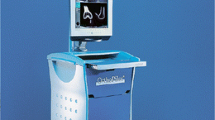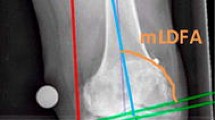Abstract
Introduction
Minimally invasive implantation of unicompartmental knee prostheses can shorten rehabilitation time and lead to better functional results than conventional implantation. Exact positioning of the implant should be achieved, as this is a factor for the long-term survival of the prosthesis, although malpositioning can result due to the poor intraoperative view when using the minimally invasive approach. Navigation of the unicompartmental prosthesis could lead to a better implant positioning without losing the advantages of a minimally invasive approach.
Materials and methods
The same unicondylar knee prosthesis was implanted in a total of 40 patients, of whom 20 were implanted using navigation (kinematic navigation) and 20 using a conventional technique. The operating time was assessed in both groups. The orientation of the tibial and femoral implants was assessed radiologically postoperatively. We analysed these results according to the optimal positioning range proposed by the manufacturer. Furthermore, we examined the clinical results with the knee society score (KSS).
Results
A good positioning of the prosthesis was observed in both techniques with only 11% of the radiologic measurements out of the proposed optimal range in each group. The operating time was significantly longer in the navigation group (17 min). The KSS did not differ between both groups at a follow-up of 16 resp. 18 months (navigated group: 184 points, conventional group: 178 points).
Conclusions
Navigation did not lead to a better positioning of the prosthesis than the conventional method and the operating time was longer. The clinical results were similar in both groups. The navigation may be a useful help for surgeons performing less unicompartmental knee arthroplasty using a minimally invasive approach.



Similar content being viewed by others
References
Mack MJ (2001) Minimally invasive and robotic surgery. JAMA 285:568–572
Pandit H, Jenkins C, Barker K, Dodd CA, Murray DW (2006) The Oxford medial unicompartmental knee replacement using a minimally-invasive approach. J Bone Joint Surg Br 88:54–60
Repicci JA, Eberle RW (1999) Minimally invasive surgical technique for unicondylar knee arthroplasty. J South Orthop Assoc 8:20–27
Müller PE, Pellengahr C, Witt M, Kircher J, Refior HJ, Jansson V (2004) Influence of minimally invasive surgery on implant positioning and the functional outcome for medial unicompartmental knee arthroplasty. J Arthroplasty 19:296–301
Price AJ, Webb J, Topf H, Dodd CA, Goodfellow JW, Murray DW (2001) Rapid recovery after oxford unicompartmental arthroplasty through a short incision. J Arthroplasty 16:970–976
Heyse TJ, Efe T, Rumpf S, Schofer MD, Fuchs-Winkelmann S, Schmitt J, Hauk C (2011) Minimally invasive versus conventional unicompartmental knee arthroplasty. Arch Orthop Trauma Surg (Epub ahead of print)
Fisher DA, Watts M, Davis KE (2003) Implant position in knee surgery: a comparison of minimally invasive, open unicompartmental, and total knee arthroplasty. J Arthroplasty 18:2–8
Jenny JY, Boeri C (2003) Unicompartmental knee prosthesis implantation with a non-image-based navigation system: rationale, technique, case-control comparative study with a conventional instrumented implantation. Knee Surg Sports Traumatol Arthrosc 11:40–45
Voss F, Sheinkop MB, Galante JO, Barden RM, Rosenberg AG (1995) Miller-Galante unicompartmental knee arthroplasty at 2- to 5-year follow-up evaluations. J Arthroplasty 10:764–771
Cartier P, Sanouiller JL, Grelsamer RP (1996) Unicompartmental knee arthroplasty surgery. 10-year minimum follow-up period. J Arthroplasty 11:782–788
Hernigou P, Deschamps G (2004) Posterior slope of the tibial implant and the outcome of unicompartmental knee arthroplasty. J Bone Joint Surg Am 86-A:506–511
Decking R, Markmann Y, Fuchs J, Puhl W, Scharf HP (2005) Leg axis after computer-navigated total knee arthroplasty: a prospective randomized trial comparing computer-navigated and manual implantation. J Arthroplasty 20:282–288
Jenny JY, Clemens U, Kohler S, Kiefer H, Konermann W, Miehlke RK (2005) Consistency of implantation of a total knee arthroplasty with a non-image-based navigation system: a case-control study of 235 cases compared with 235 conventionally implanted prostheses. J Arthroplasty 20(2005):832–839
Stockl B, Nogler M, Rosiek R, Fischer M, Krismer M, Kessler O (2004) Navigation improves accuracy of rotational alignment in total knee arthroplasty. Clin Orthop Relat Res 426:180–186
Haaker RG, Wojciechowski M, Patzer P, Willburger RE, Senkal M, Engelhardt M (2006) Minimally invasive unicondylar knee replacement with computer navigation. Orthopade 35:1073–1079
Jung KA, Kim SJ, Lee SC, Hwang SH, Ahn NK (2010) Accuracy of implantation during computer-assisted minimally invasive Oxford unicompartmental knee arthroplasty: a comparison with a conventional instrumented technique. Knee 17:387–391
Lim MH, Tallay A, Bartlett J (2009) Comparative study of the use of computer assisted navigation system for axial correction in medial unicompartmental knee arthroplasty. Knee Surg Sports Traumatol Arthrosc 17:341–346
Lonner JH, John TK, Conditt MA (2010) Robotic arm-assisted UKA improves tibial component alignment: a pilot study. Clin Orthop Relat Res 468:141–146
Perlick L, Bathis H, Tingart M, Perlick C, Luring C, Grifka J (2004) Minimally invasive unicompartmental knee replacement with a nonimage-based navigation system. Int Orthop 28:193–197
Rosenberger RE, Fink C, Quirbach S, Attal R, Tecklenburg K, Hoser C (2008) The immediate effect of navigation on implant accuracy in primary mini-invasive unicompartmental knee arthroplasty. Knee Surg Sports Traumatol Arthrosc 16:1133–1140
Seon JK, Song EK, Park SJ, Yoon TR, Lee KB, Jung ST (2009) Comparison of minimally invasive unicompartmental knee arthroplasty with or without a navigation system. J Arthroplasty 24:351–357
Jenny JY, Müller PE, Weyer R, John M, Weber P, Ciobanu E, Schmitz A, Bacher T, Neumann W, Jansson V (2006) Navigated minimally invasive unicompartmental knee arthroplasty. Orthopedics 29:S117–S121
Goslings JC, Gouma DJ (2008) What is a surgical complication? World J Surg 32:952
Dupont WD, Plummer WD (1998) Power and sample size calculations for studies involving linear regression. Control Clin Trials 19:589–601
Cossey AJ, Spriggins AJ (2005) The use of computer-assisted surgical navigation to prevent malalignment in unicompartmental knee arthroplasty. J Arthroplasty 20:29–34
Aldinger PR, Gill HS, Schlegel U, Schneider M, Clauss M, Goodfellow JW, Murray DW, Breusch SJ (2004) Is computer navigation a useful tool in unicompartmental knee arthroplasty? A pilot cadaver study. Orthopade 34:1094–1102
Robertsson O, Knutson K, Lewold S, Lidgren L (2001) The routine of surgical management reduces failure after unicompartmental knee arthroplasty. J Bone Joint Surg Br 83:45–49
Gulati A, Pandit H, Jenkins C, Chau R, Dodd CA, Murray DW (2009) The effect of leg alignment on the outcome of unicompartmental knee replacement. J Bone Joint Surg Br 91:469–474
Kennedy WR, White RP (1987) Unicompartmental arthroplasty of the knee. Postoperative alignment and its influence on overall results. Clin Orthop Relat Res 221:278–285
Hernigou P, Deschamps G (2004) Alignment influences wear in the knee after medial unicompartmental arthroplasty. Clin Orthop Relat Res 423:161–165
Utzschneider S, Goettinger M, Weber P, Horng A, Glaser C, Jansson V, Müller PE (2011) Development and validation of a new method for the radiologic measurement of the tibial slope. Knee Surg Sports Traumatol Arthrosc (Epub ahead of print)
Benjamin J (2006) Component alignment in total knee arthroplasty. Instr Course Lect 55:405–412
Weber P, Schröder C, Utzschneider S, Jansson V, Müller PE (2011) A high tibial slope reduces wear in unicondylar knee arthroplasty [German]. In: Proceedings of the symposium for experimental orthopedics at the orthopedic clinic of the Ludwig–Maximilians University Munich. Unfallchirurg 114, p S13
Diezi C, Wirth S, Meyer DC, Koch PP (2010) Effect of femoral to tibial varus mismatch on the contact area of unicondylar knee prostheses. Knee 17:350–355
Clarius M, Hauck C, Seeger JB, Pritsch M, Merle C, Aldinger PR (2010) Correlation of positioning and clinical results in Oxford UKA. Int Orthop 34:1145–1151
Hauptmann SM, Weber P, Glaser C, Birkenmaier C, Jansson V, Muller PE (2008) Free bone cement fragments after minimally invasive unicompartmental knee arthroplasty: an underappreciated problem. Knee Surg Sports Traumatol Arthrosc 16:770–775
Seon JK, Song EK, Yoon TR, Seo HY, Cho SG (2007) Tibial plateau stress fracture after unicondylar knee arthroplasty using a navigation system: two case reports. Knee Surg Sports Traumatol Arthrosc 15:67–70
Song MH, Kim BH, Ahn SJ, Yoo SH, Lee MS (2009) Early complications after minimally invasive mobile-bearing medial unicompartmental knee arthroplasty. J Arthroplasty 24:1281–1284
Lewold S, Goodman S, Knutson K, Robertsson O, Lidgren L (1995) Oxford meniscal bearing knee versus the Marmor knee in unicompartmental arthroplasty for arthrosis: a Swedish multicenter survival study. J Arthroplasty 10:722–731
Hamilton WG, Collier MB, Tarabee E, McAuley JP, Engh CA Jr, Engh GA (2006) Incidence and reasons for reoperation after minimally invasive unicompartmental knee arthroplasty. J Arthroplasty 21:98–107
Cerha O, Kirschner S, Gunther KP, Lutzner J (2009) Cost analysis for navigation in knee endoprosthetics. Orthopade 38:1235–1240
Conflict of interest
The authors VJ and PEM were involved in the development of the surgical technique of the Univation and are paid consultant for Aesculap AG (Tuttlingen, Germany). This did, however, not influence the study design, the collection, analysis and interpretation, of data. Aesculap AG was also not involved in the writing of the manuscript and in the decision to submit the manuscript for publication.
Author information
Authors and Affiliations
Corresponding author
Rights and permissions
About this article
Cite this article
Weber, P., Utzschneider, S., Sadoghi, P. et al. Navigation in minimally invasive unicompartmental knee arthroplasty has no advantage in comparison to a conventional minimally invasive implantation. Arch Orthop Trauma Surg 132, 281–288 (2012). https://doi.org/10.1007/s00402-011-1404-4
Received:
Published:
Issue Date:
DOI: https://doi.org/10.1007/s00402-011-1404-4




